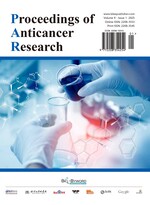Abstract
Objective: This study investigates the preventive and therapeutic effects of medical radiation protection spray (Bergmann) compared to triethanolamine cream in patients undergoing radiotherapy following breast cancer surgery. Methods: Ninety patients with breast cancer who received postoperative radiotherapy between July 2018 and July 2021 were randomly divided into the Bergmann treatment (experimental) group and the triethanolamine cream treatment (control) group, with 45 patients in each group. Radiodermatitis severity was assessed using the RTOG radiodermatitis grading standards. Results: The radiation dose required to develop grade I radiodermatitis was significantly higher in the experimental group compared to the control group, at (36.13 ± 1.17 Gy) and (25.38 ± 0.63 Gy), respectively. At a radiation dose of 30 Gy, the proportion of grade I radiodermatitis cases in the experimental group was significantly lower than in the control group (P = 0.002). At radiation doses of 40 Gy and 50 Gy, the proportion of grade II radiodermatitis cases in the experimental group was also significantly lower than in the control group (P < 0.001). No cases of grade III or higher radiodermatitis were observed in the experimental group, while three cases of grade III radiodermatitis occurred in the control group, although the difference was not statistically significant. No patients in the experimental group discontinued treatment due to radiodermatitis or mucosal reactions, whereas two patients in the control group interrupted treatment due to these reactions but eventually completed therapy. Conclusion: Bergmann spray effectively prevents radiodermatitis in patients undergoing radiotherapy after breast cancer surgery and is more effective than triethanolamine cream in treating skin lesions. Its ease of use improves the quality of life for patients undergoing radiotherapy and ensures successful treatment completion. Bergmann is suitable for clinical promotion and application.
References
Bray F, Ferlay J, Soerjomataram I, et al., 2018, Global Cancer Statistics 2018: GLOBOCAN Estimates of Incidence and Mortality Worldwide for 36 Cancers in 185 Countries. CA Cancer J Clin, 68(6): 394–424. https://doi.org/10.3322/caac.21492. Erratum in CA Cancer J Clin, 70(4): 313. https://doi.org/10.3322/caac.21609
Zhang X, Li H, Li Q, et al., 2018, Application of Red Light Phototherapy in the Treatment of Radioactive Dermatitis in Patients with Head and Neck Cancer. World J Surg Oncol, 16(1): 222. https://doi.org/10.1186/s12957-018-1522-3
Zenda S, Yamaguchi T, Yokota T, et al., 2018, Topical Steroid Versus Placebo for the Prevention of Radiation Dermatitis in Head and Neck Cancer Patients Receiving Chemoradiotherapy: The Study Protocol of J-SUPPORT 1602 (TOPICS Study), a Randomized Double-Blinded Phase 3 Trial. BMC Cancer, 18(1): 873. https://doi.org/10.1186/s12885-018-4763-1
Pixberg C, Koch R, Eich HT, et al., 2016, Acute Toxicity Grade 3 and 4 After Irradiation in Children and Adolescents: Results From the IPPARCA Collaboration. Int J Radiat Oncol Biol Phys, 94(4): 792–799. https://doi.org/10.1016/j.ijrobp.2015.12.353
Narvaez C, Doemer C, Idel C, et al., 2018, Radiotherapy Related Skin Toxicity (RAREST-01): Mepitel® Film Versus Standard Care in Patients with Locally Advanced Head-and-Neck Cancer. BMC Cancer, 18(1): 197. https://doi.org/10.1186/s12885-018-4119-x
Pasquier D, Le Tinier F, Bennadji R, et al., 2019, Intensity-Modulated Radiation Therapy with Simultaneous Integrated Boost for Locally Advanced Breast Cancer: A Prospective Study on Toxicity and Quality of Life. Sci Rep, 9(1): 2759. https://doi.org/10.1038/s41598-019-39469-8
Liochev SI, 2013, Reactive Oxygen Species and the Free Radical Theory of Aging. Free Radic Biol Med, 60: 1–4. https://doi.org/10.1016/j.freeradbiomed.2013.02.011
Zenda S, Ota Y, Tachibana H, et al., 2016, A Prospective Picture Collection Study for a Grading Atlas of Radiation Dermatitis for Clinical Trials in Head-and-Neck Cancer Patients. J Radiat Res, 57(3): 301–306. https://doi.org/10.1093/jrr/rrv092
Méry B, Vallard A, Trone JC, et al., 2015, Correlation Between Anthropometric Parameters and Acute Skin Toxicity in Breast Cancer Radiotherapy Patients: A Pilot Assessment Study. Br J Radiol, 88(1055): 20150414. https://doi.org/10.1259/bjr.20150414
Blanchecotte J, Ruffier-Loubière A, Reynaud-Bougnoux A, et al., 2015, Toxicité Aiguë Cutanée de L’irradiation Mammaire Avec Modulation D’intensité Avec Technique de Champ Dans le Champ (Optimisation Avec Pré-Segmentation) [Acute Skin Toxicity in Breast Intensity Modulated Radiotherapy Using Field in Field Technique]. Cancer Radiother, 19(2): 82–88. https://doi.org/10.1016/j.canrad.2014.10.007
De Langhe S, Mulliez T, Veldeman L, et al., 2014, Factors Modifying the Risk for Developing Acute Skin Toxicity After Whole-Breast Intensity Modulated Radiotherapy. BMC Cancer, 14: 711. https://doi.org/10.1186/1471-2407-14-711
Kawamura K, Qi F, Meng Q, et al., 2019, Nucleolar Protein Nucleolin Functions in Replication Stress-Induced DNA Damage Responses. J Radiat Res, 60(3): 281–288. https://doi.org/10.1093/jrr/rry114
Vulin A, Sedkaoui M, Moratille S, et al., 2018, Severe PATCHED1 Deficiency in Cancer-Prone Gorlin Patient Cells Results in Intrinsic Radiosensitivity. Int J Radiat Oncol Biol Phys, 102(2): 417–425. https://doi.org/10.1016/j.ijrobp.2018.05.057
Qiao Y, Hu CX, Song DA, et al., 2017, High Throughput-Targeted Sequencing Panel for Exploring Radiosensitivity Associated Genes in Esophageal Squamous Cell Carcinoma. Zhonghua Zhong Liu Za Zhi, 39(8): 584–588. https://doi.org/10.3760/cma.j.issn.0253-3766.2017.08.005
Liu Z, Yu D, Xu J, et al., 2018, Human Umbilical Cord Mesenchymal Stem Cells Improve Irradiation-Induced Skin Ulcers Healing of Rat Models. Biomed Pharmacother, 101: 729–736. https://doi.org/10.1016/j.biopha.2018.02.093
